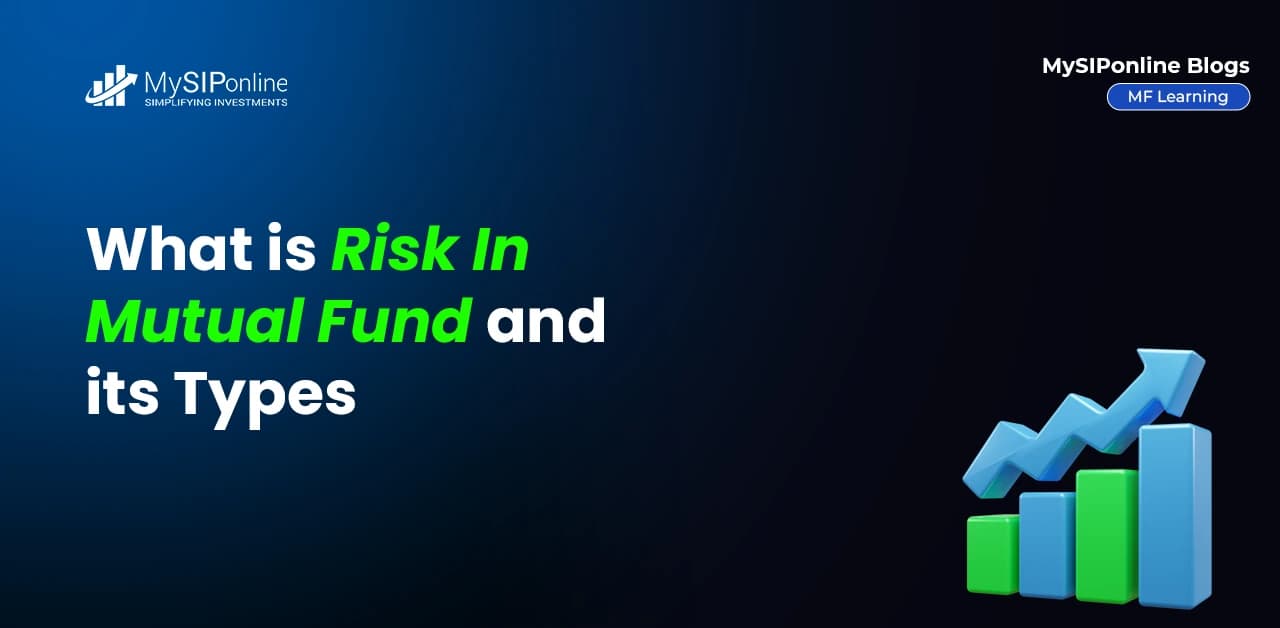Table of Contents
Do you know that over 5.26 crore investors in India invested in Mutual Funds in 2024, up from 4.20 crore the previous year? This shows that despite risks, millions still trust mutual funds because they can be managed with smart solutions.
As Warren Buffett said, “Risk comes from not knowing what you are doing.” Understanding the risks is the first step to informed investing.
The Risk in mutual funds is the possibility that your returns may differ from expectations. Some risks are small, others may be major. By knowing the types, market, credit, interest rate and liquidity risk, you can make wise choices, protect your money and grow it effectively.
Connect with us for your portfolio benefits and personalized advice.
What Makes Mutual Funds Investment Risky?
Here are the main factors that make mutual fund investment risky:
- Such as market volatilitycan affect returns, while rising interest rates may reduce bond values. Low-rated bonds might default and some assets are hard to sell instantly, impacting fund performance.
- Additionally, inflation, recessionor changes in government policies can influence the value of your fund. NAV decline can also result in the loss of your investment money.
- All funds have some risk, but you can reduce risk by investing through a small amount of SIPfor the long term.
Fund Fact: Mutual funds are less risky than stocks as they spread money by diversification.
Start Your SIP TodayLet your money work for you with the best SIP plans.
Types of Risk Considered in Mutual Funds
Here is the list of different types of risk in MFs involved:
-
Market Risk (Systematic Risk)
This is the risk that comes from ups and downs in the entire stock or bond markets. If the market falls, the value of your mutual fund can also go down, even if the companies are doing well, and it may be significantly affected by economic crises, global events and geopolitical reasons.
-
Credit Risk
Credit risk happens when the companies or bonds your mutual fund invests in might fail to pay back their loans or meet their financial promises. If that happens, your investment value can drop and decline.
-
Interest Rate Risk
Mostly seen in debt funds, this is when changes in interest rates affect the value of the bonds in your fund. If interest rates go up, older bonds paying lower rates become less valuable.
-
Liquidity Risk
This is the risk of not being able to sell investments quickly without losing money. In rare cases, if too many investors try to take out their money at once, the fund might struggle to redeem.
-
Inflation Risk
This is when the returns from your mutual fund do not grow fast enough to keep up with the rising cost of living, making your money’s buying power weaker over time.
-
Management Risk
Mutual funds are managed by fund managers, and their expertise directly affects your returns. If they make poor investment decisions, the performance of the fund can be affected.
Pro Tip: Find risk & growth of MF in seconds with the Mutual Funds Screener.
Let us now explore the risks involved with Equity Mutual Funds.
Risks Associated with Mutual Funds
In mutual funds, an expert fund manager invests your money in a mix of assets like equity, bonds and other asset classes. This mix is known as diversification, which helps investors reduce risk, but mutual funds still contain some risk as they are subject to the market.
In simple terms, risk means the chance that your investment might not give the expected return or you might lose money.
Even low-risk mutual fund investments can lose value due to market volatility, interest rate changes or defaults, so it cannot be said that any mutual fund is 100% safe. SIP can reduce the effect of market ups and downs by investing consistently, but it cannot remove risk. If markets fall, your SIP value can still go down temporarily.
Example: If you invest in a debt mutual fund and interest rates suddenly rise, the price of older bonds in your fund will drop, reducing your fund's overall value.
Also Read: Mutual Fund Vs Stocks: Which is a better investment in 2025?
Risks Involved with Equity Mutual Funds
The table below shows the major types of risks in equity mutual funds with the reason and their example:
| Type of Risk | Definition & Reason | Example |
|---|---|---|
| Market Risk | The risk of loss due to overall market downturns, caused by economic slowdowns, geopolitical stress or market crashes. | Equity funds lose value during a recession. |
| Concentration Risk | Risk from heavy investment in a specific sector or stock, caused by a lack of diversification. | A tech-focused equity fund falls sharply when the tech sector underperforms. |
| Liquidity Risk | Difficulty in selling securities without quick price loss, caused by low trading volumes in certain stocks. | Small-cap equity funds are hard to liquidate or redeem quickly during a market panic. |
| Currency Risk | Risk of value loss due to foreign exchange fluctuations; occurs if the fund invests in overseas equities. | An international equity fund loses value when the foreign currency depreciates against the investor’s home currency. |
| Inflation Risk | Risk that returns may not beat inflation, caused by rising prices reducing purchasing power. | Equity returns of 4% when inflation is at 6%. |
| Regulatory/Political Risk | Risk of changes in government policies, taxes, or regulations affecting companies’ profitability. | Equity funds in the energy sector are impacted by new environmental regulations. |
| Fund Manager Risk | Risk that poor decisions by the fund manager reduce returns, caused by wrong stock picks or bad timing. | The active equity fund is underperforming due to incorrect market predictions. |
Pro Tip: Calculate your compounding returns using the SIP Calculator free of cost.
Risks Involved with Debt Mutual Funds
The table below shows the major types of risks in debt mutual funds, with the reason and their example:
| Type of Risk | Definition & Reason | Example |
|---|---|---|
| Interest Rate Risk | The risk that bond prices will fall when interest rates rise, caused by the inverse relationship between rates and bond prices. | A long-term government bond fund loses value after a central bank rate raises. |
| Credit Risk (Default Risk) | Risk that the issuer of a bond will fail to pay interest or principal, caused by the poor financial health of the issuer. | A corporate bond fund suffers losses due to a company faces on debt. |
| Liquidity Risk | Difficulty selling bonds without a loss, caused by low trading volumes in certain debt instruments. | A debt fund holding low-rated corporate bonds that can’t be sold quickly in a downturn. |
| Reinvestment Risk | Risk that interest income or matured bonds will be reinvested at lower rates, caused by declining interest rates. | A debt fund reinvests coupon payments when market rates drop. |
| Inflation Risk | Risk that returns will not keep up with inflation, caused by rising prices eroding real returns. | A debt fund yielding 5% when inflation is at 6%. |
| Concentration Risk | Risk from holding a large portion of assets in a single issuer or sector, caused by a lack of diversification. | A debt fund heavily invested in one company’s bonds loses value when that company’s credit rating is downgraded. |
| Regulatory/Political Risk | Risk that changes in regulations or government policies may affect debt markets, caused by policy shifts or new rules. | Debt funds are impacted by sudden tax changes on debt instruments. |
| Fund Manager Risk | The risk that poor investment decisions by the manager reduce returns, caused by wrong bond selection or interest rate forecasting. | Actively managed debt fund underperforming due to incorrect duration strategy. |
Let us simplify the smart tips for you to reduce risks in MFs.
Smart Tips to Reduce Risks in Mutual Funds
Sumi wanted to start investing in mutual funds, so she decided to handle her investments wisely. By following some smart steps, you can reduce risks:
1. Matching Risk Capacity
First, Sumi defines her risk capacity, so for long-term goals, she chose a balanced approach. In this, she puts more in equity-related instruments for growth and some in debt funds or bonds for safety. This matched her comfort level and risk capacity.
2. Investing Through SIP
She picked a Systematic Investment Plan (SIP). This helped her invest small amounts regularly, benefit from rupee-cost averaging and reduce stress from market fluctuations.
3. Using STP for Smooth Transfers
Later, when Sumi received a lumpsum, she used a Systematic Transfer Plan (STP) to move money from a debt fund into equity funds slowly. This reduced the impact of sudden interest rate changes, inflation, or market volatility.
4. Diversifying Portfolio
Sumi spread her investments across equity, debt, corporate bonds and gold funds. She also kept an eye on governmental policies, RBI policies, SEBI regulations and geopolitical events. Diversification balanced the poor performance in one asset class, so that it did not hurt her overall returns.
5. Following Trusted Advice
She takes advice from SEBI-registered financial advisors, mutual fund advisors and investment advisers. She also checked verified info through the AMFI link and followed the regulatory framework and SEBI circulars. This helped her make informed, safe choices.
Smart Investments, Bigger Returns
Pro Tip: Use an SWP Calculator to visualize your investment growth and set goals.
Conclusion
To sum up, as with any investment, Mutual funds also come with risks. However, the key is not to avoid these risks but to manage them smartly. By knowing types of risks in equity & debt mutual funds, investors can make a formal decision instead of chasing returns.
In mutual fund investing, risk can never be eliminated, but with the right strategy, it can always be managed.” Building a portfolio that matches your risk capacity, investing through SIPs and STPs & diversifying across asset classes are practical strategies that help you reduce the impact of market volatility.
In the end, remember, do not fear the risks in mutual funds, shape them into opportunities with discipline, patience and smart choices.”
Frequently Asked Questions
-
What is the risk of SIP?
SIPs reduce market timing risk by investing at regular intervals, but returns can still fluctuate with the market, interest rates and economic changes.
-
Why is mutual fund investment risky?
Mutual funds invest in a range of assets such as equities, bonds and other assets that are affected by market volatility, interest rates & global crises.
-
Is a mutual fund 100% safe?
No. As mutual funds are subject to market risk. Debt funds are far safer, but equity funds carry market risks.
-
Is it risky to invest in mutual funds now?
Risk depends on market swings. Equity funds are volatile during inflation or geopolitical tensions, while debt funds are more stable.
-
Are mutual funds safe for the long term?
Yes, long-term investments in diversified funds can reduce volatility & benefit from compounding.
-
Can mutual funds go to zero?
In very rare case, Equity funds can lose major value during crashes; debt funds face credit risks.
-
What are historical mutual fund returns?
Equity funds: ~10–15% annually, Debt funds: ~5–7%. Past returns show potential growth, not guaranteed profits.











.webp&w=3840&q=75)



